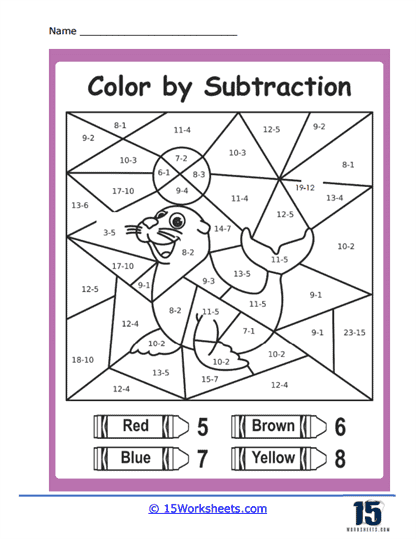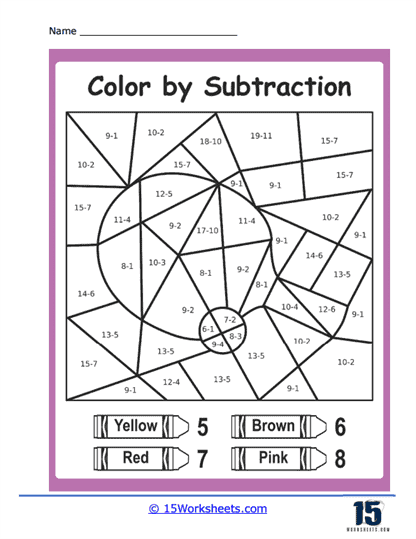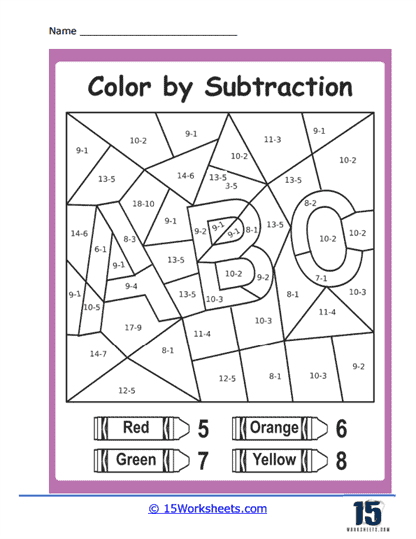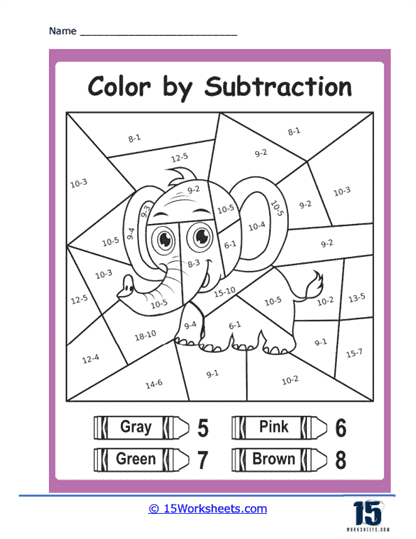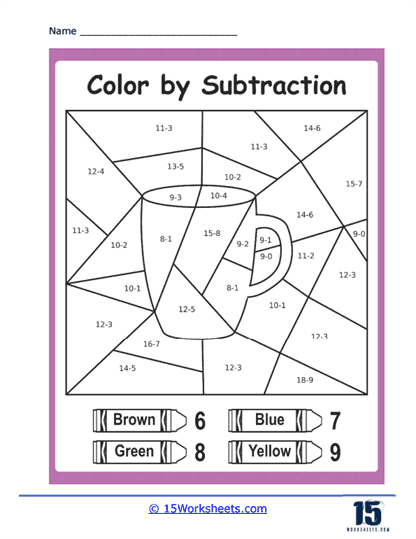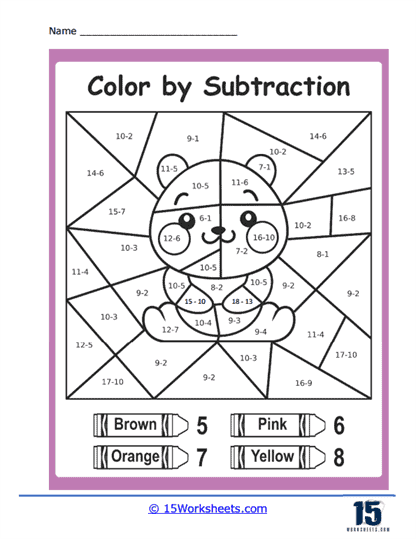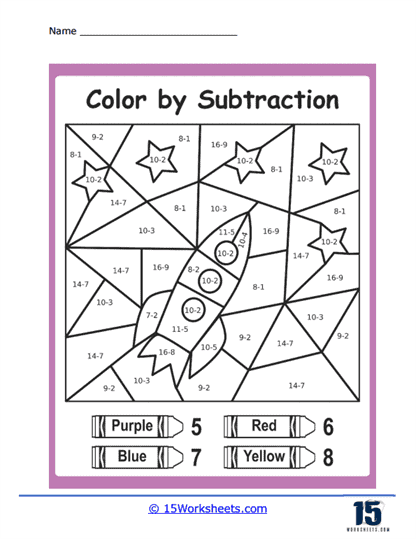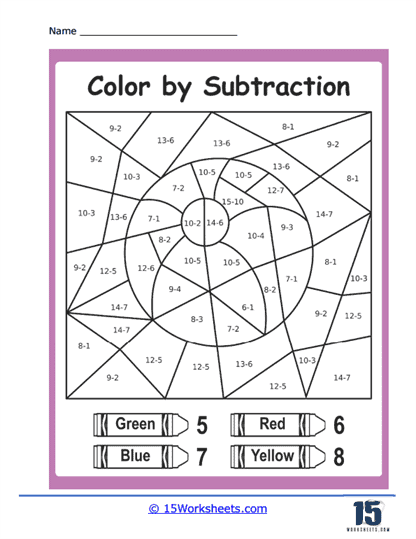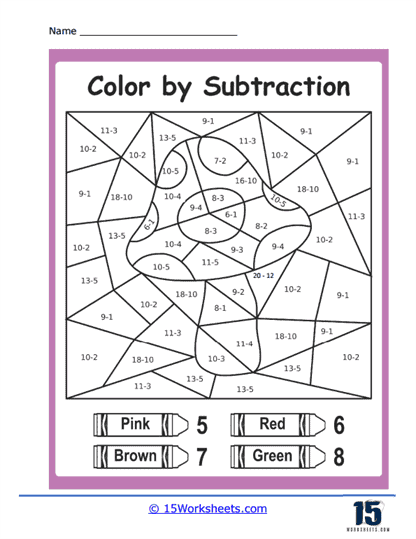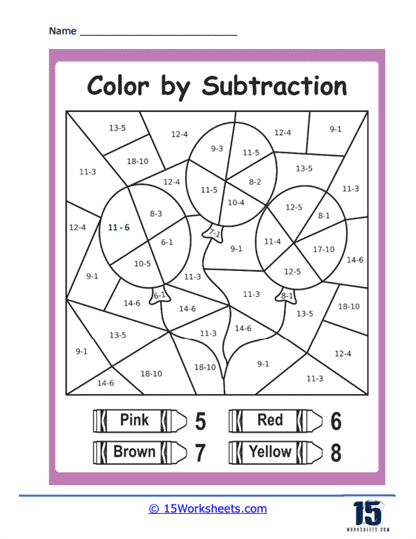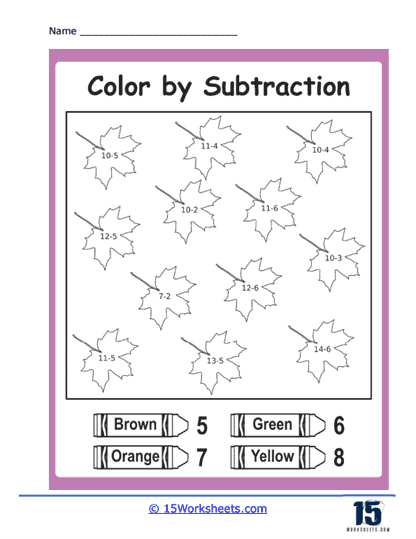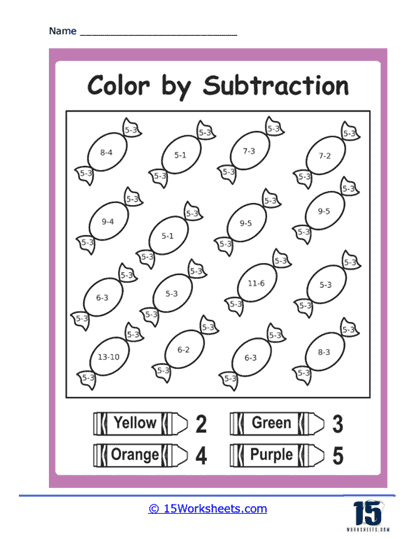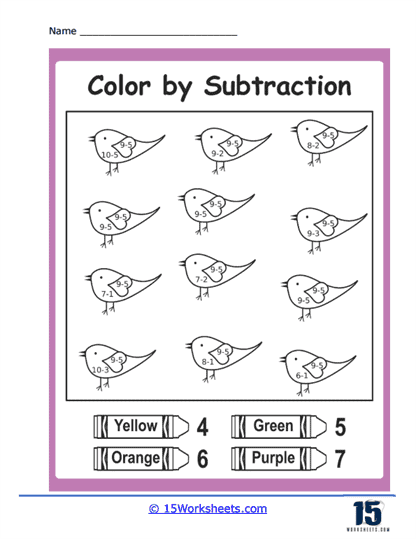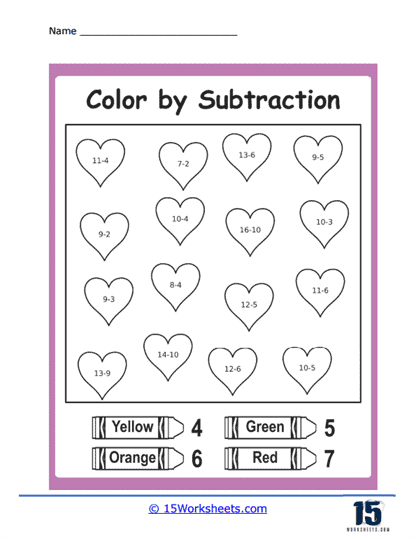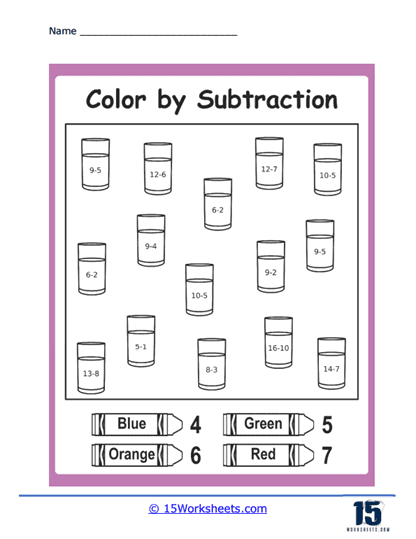Color By Subtraction Worksheets
About These 15 Worksheets
These worksheets mix math and art together. Imagine a coloring page, but instead of just coloring it any way you want, there are subtraction fact problems on it. Each problem gives you a hint on which color to use. The fun part? As you solve each subtraction problem and color in the spaces, a surprise picture begins to appear!
Subtraction picture puzzle worksheets offer teachers a powerful way to engage their students in mathematics. By combining math problems with creative coloring tasks, these worksheets transform subtraction practice into an enjoyable and interactive experience. This engagement is particularly valuable for young learners who may find repetitive number problems less appealing. As students work through the subtraction problems and apply their solutions to coloring the corresponding parts of an image, they receive immediate feedback. This feedback reinforces their understanding of subtraction as they see the image come to life based on their correct answers.
A Look At Individual Worksheets
Imagine diving into the “Seal Subtraction” worksheet, where each correct answer brings a playful seal to life with vibrant colors. Or perhaps you’re deciphering the hidden message in “Can You See It,” where solving subtraction problems reveals a surprise image, turning students into math detectives. “Subtract First 3 Letters” adds a linguistic twist, combining letter recognition with numerical skills, making learning multifaceted and fun.
For those with a penchant for the whimsical, “Elephant Differences” offers a jumbo-sized challenge, while “Coffee Cup” perks up the routine with a steaming cup of subtraction. “Teddy Bear Subtraction” invites learners to a cozy math picnic, and “Subtract Blast Off” propels them into a space-themed numerical journey. “Beachball” and “Mushroom Subtraction” add a splash of seasonal fun, ensuring that learning remains fresh and exciting.
Celebrations are in order with “Birthday Balloons,” where each correct answer inflates a balloon, and “Falling Leaves,” which captures the essence of autumn through colorful arithmetic. “Hard Candy” sweetens the deal, making each problem a treat, while “Subtraction is For The Birds” chirps in with avian-themed challenges. “Subtract Heart” warms the heart with love-infused problems, and “Half Empty” teaches optimism through math, proving that the glass is always half full when you’re learning.
These worksheets are more than just educational tools; they’re a testament to the joy of learning. By blending art and mathematics, they cater to various learning styles, ensuring that every student finds a path to success. So grab your crayons, sharpen those pencils, and embark on a colorful journey through the world of subtraction!
How Do You Complete These Worksheets?
Look at the Color Key and Solve – At the side or bottom of the page, you’ll find a list of colors and numbers. For example, you might see “Red – 5”, which means if you get the answer 5, you color that space red. Each part of the picture will have a subtraction problem, like “9 – 4”. Do the math! For this example, 9 minus 4 equals 5.
Match the Answer to the Color – Once you have the answer, look at the color key. Using our example, if the answer is 5, you’ll look at the color for number 5 (which was red) and color that space red. Solve each math problem and color each section until the entire picture is colored in!
Reveal the Surprise – When you’re done, a hidden image will appear! It could be anything – a smiling sun, a starry night, or even a cute animal. The mystery is part of the excitement.
Why To Use These Types of Activities
There is a good deal of research around the efficacy of integrating art into academic learning. Here’s a breakdown:
Integrated Learning Approach – Studies have suggested that integrating subjects, like math and art, can enhance understanding and retention. When students make connections across different disciplines, they engage multiple areas of their brains, leading to deeper learning.
Engagement – Engaging activities, such as coloring, can help maintain students’ interest in a task. When students are interested, they are more likely to be motivated and put effort into the activity. Motivation plays a critical role in learning, and research has consistently shown that engaged students tend to learn more and perform better in school.
Multi-sensory Learning – These worksheets tap into multi-sensory learning. Using visual (seeing), kinesthetic (coloring), and cognitive (subtracting) skills together can make learning more memorable. Studies have indicated that multi-sensory approaches can be especially beneficial for students with different learning styles and needs.
Growth Mindset – Activities that allow for mistakes and problem-solving can promote a growth mindset, the belief that abilities can be developed through dedication and hard work. In coloring worksheets, getting a color or answer wrong isn’t a failure; it’s an opportunity to learn and improve. Research by Dr. Carol Dweck and others has demonstrated that students with a growth mindset tend to embrace challenges, persist in the face of setbacks, and see effort as a path to improvement.
Fine Motor Skills and Hand-Eye Coordination – Beyond mathematics, these worksheets contribute to students’ physical and cognitive development. Coloring within the lines demands precision and fine motor control, which is vital for young learners’ overall development and can support other academic skills, such as writing. Additionally, these activities encourage critical thinking. To complete the image accurately, students must solve each subtraction problem correctly. This requirement fosters a careful and meticulous approach to their work, emphasizing the importance of accuracy in mathematical calculations.
Relaxation and Stress Relief – Several studies suggest that coloring can be a form of meditation and can reduce anxiety. When students are relaxed, their minds are more open to learning.
Different students have different needs, and what works well for one might not work as effectively for another. Still, integrating art with academics offers a creative way to reinforce learning and make it enjoyable.
Teachers appreciate these worksheets for their ability to cater to diverse learning styles. Visual and kinesthetic learners, in particular, benefit from this approach. The visual aspect engages students through art and imagery, while the kinesthetic element involves hands-on coloring. This means that subtraction picture puzzle worksheets can be a valuable tool for differentiated instruction, allowing teachers to adapt their teaching methods to meet the unique needs and preferences of their students.

